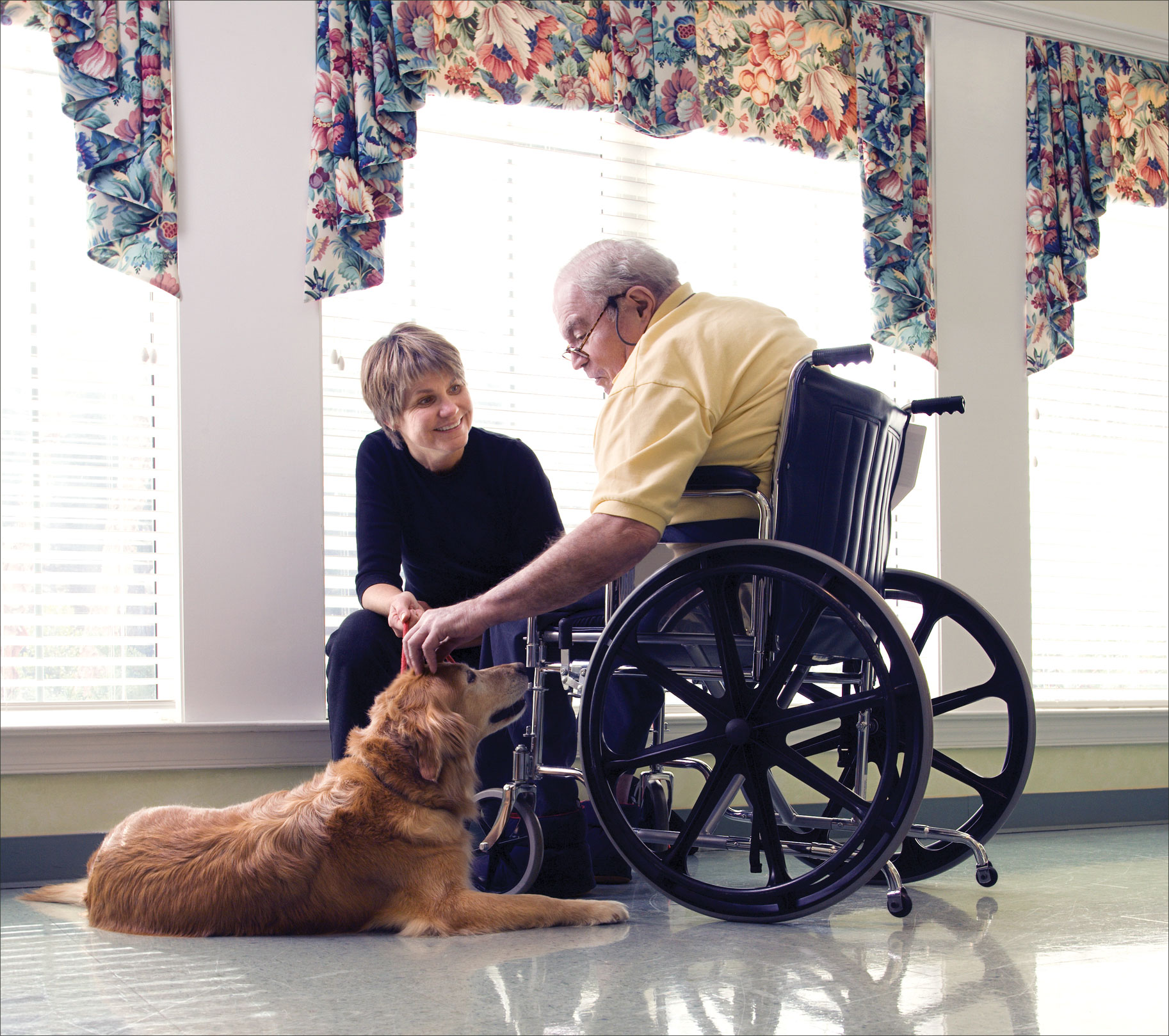No good deed goes unpunished. That’s what Pam Rowley of Upper Brookville, New York, discovered last November, when the hospital administrator who always greeted her and 8-year-old Vizsla Gunner at the start of their monthly therapy-dog visits quietly took her aside to deliver some bad news.

288
“She said that the hospital has some new rules for the therapy dogs,” Rowley remembers. “One of the rules stated that there can be no dogs in the hospital who have eaten raw food within 90 days of a visit. I told her that Gunner is on a diet that includes raw food, and I felt that it was beneficial to his health.”
The administrator was sympathetic, but the rule was non-negotiable. After four years of these monthly visits – never with any documented incidents or illness resulting from them – Gunner was no longer welcome.
Rowley’s predicament is emblematic of the challenges faced by many who decide to take an “outside the box” approach to their dogs’ care and rearing – and these challenges do not apply only to therapy dogs. Owners who opt to vaccinate minimally often encounter similar obstacles when they board their dogs at kennels, register them for doggie day care, or even enroll them in training classes, because their individualized vaccine protocol falls short of across-the-board “requirements” such as annual or non-core vaccinations.
What to do? Capitulate and give up health practices that you think are optimal for your dog, even if you believe the rules are misguided? Or eschew any activity that requires you to subject your dog to a diet or veterinary procedure that you feel is potentially harmful to your dog’s long-term health?
Only you can make the decisions that are best for you and your dog. You may choose to “go along to get along” if the activities are important enough to you. Or you may regard your dog’s health as your ultimate priority – and want to have no regrets about your choices later. In some cases, there may be relatively unexplored middle ground – a place where you can provide responsible care for your dog while continuing to participate in a mainstream activity.
FOOD FOR THOUGHT
In the case of Pam Rowley and her raw-fed therapy dog, the hospital’s change of policy regarding Gunner’s visits resulted from guidelines that the administrator said were issued by the Centers for Disease Control and Prevention.
For someone who is committed to feeding raw, that could be the end of visits to that facility. Rowley could try to find another hospital or type of program for Gunner to visit – perhaps one that doesn’t care for medically fragile patients, such as a behavioral health unit or a reading program for kids, which he already participates in. If she felt a strong commitment to the program she’s volunteered with for years, she could consider another type of healthy diet for Gunner, such as a home-prepared cooked diet.
Or, she could dig in and try to find the source of the hospital administrator’s edict, and try to educate folks along the bureaucratic chain of command that a raw-fed dog transmitting Salmonella to patients is not a foregone conclusion.
She could start with the fact that, despite what the administrator told her, the CDC does not have a formal position on raw-fed therapy dogs. Instead, its 2011 document, “Compendium of Measures to Prevent Disease Associated with Animals in Public Settings,” refers to “guidelines” that the CDC says were developed by the Association for Professionals in Infection Control and Epidemiology (APIC) and the Animal-Assisted Interventions Working Group (AAI).
However, “Guidelines for Animal-Assisted Interventions in Health Care Facilities” is not a position paper of the APIC, according to a media spokesperson for the group. It was published in March 2008 in APIC’s peer-reviewed journal, American Journal of Infection Control. Among the paper’s recommendations: “Exclude any animal that has been fed any raw or dehydrated (but otherwise raw) foods, chews, or treats of animal origin within the past 90 days,” which presumably also covers pig ears and bully sticks.
Certainly, studies have shown that dogs can shed bacteria into their environment. A 2007 study by Sandra Lefebvre, DVM (one of the authors of the APIC-published paper), found that therapy dogs that were fed raw meat were “significantly more likely” to shed salmonella than those not fed it. In 2002, a study published in The Canadian Veterinary Journal isolated Salmonella from 80 percent of bones-and-raw-food diet samples and 30 percent of dogs fed the diet.
Yet commercial kibble diets are not guaranteed to be bacteria-free, either. In the past year, a number of pet food companies have announced voluntary recalls of dry dog foods due to possible Salmonella contamination, including Wellness, Natural Balance, Taste of the Wild (Diamond), AvoDerm (Breeder’s Choice), and most recently, California Natural, Innova, and other products made by Natura Pet Products.
The larger question that looms is, how much of a problem is a Salmonella-shedding dog to the human population?
Dogs who are fed diets that contain Salmonella can shed the bacteria in their feces and saliva. The mere act of normal self-grooming (licking their coats) can transfer the Salmonella organisms to their fur. “And my answer is: ‘Yes, and …?’ This is not the end of the conversation,” says canine nutrition consultant Monica Segal of Toronto, Canada. “We probably could agree that poultry-processing plants have the highest Salmonella counts, and we should expect that people who work at those plants would be hospitalized daily.”
They aren’t, suggesting that fears over Salmonella shedding in raw-fed dogs are, in her words, “over the top,” though of course, special precautions should be taken with severely immunocompromised individuals with all dogs, not just raw-fed ones. “Frankly, I don’t believe that it has been proven that, yes, this dog eating kibble is perfectly safe to be around, but this raw-fed one is not,” Segal concludes.
Integrative veterinarian Dr. Julie Mayer, DVM, CVA, CVC, CCRP, of Tucson, Arizona, has a rather straightforward way of reassuring those whose conventional veterinarians warn against the multitudes of microbes lurking in a raw-food diet.
“I say, go back to your vet and say, ‘Dogs lick their butts,’” she says. “Dogs are out there eating goose poop, eating grass, eating other dogs’ poop. They are going to be shedders of Salmonella and E. coli,” even if they aren’t raw-fed.
There are many things that therapy dog owners can do – and should do, regardless of the dog’s diet – to protect any patients who interact with their dogs from any sort of potential infection. These practices include not permitting licking or doggie kisses, and providing patients and staff with hand sanitizer after all interactions.
These practices also protect therapy dogs from getting exposed to infectious agents that patients may transmit. And, given the current epidemic of Methicillin-resistant Staphylococcus aureus (MRSA) infection in human hospitals, that’s a valid concern. A recent Canadian study of 26 therapy dogs in hospital and long-term-care facilities found that while none of the dogs were contaminated with common infection-causing bacteria before they entered the facilities, two were positive afterward. One, a Greyhound, had Clostridium difficile (a Gram-positive bacteria that can cause severe diarrhea) on his paws. The other, a Pug, had MRSA detected on his fur after he spent time on patients’ beds and was kissed repeatedly by two of them.
Hospitals are not the only place where therapy dogs can be of benefit. Library reading programs, day programs for the mentally challenged, rehabilitation and outpatient centers – all are possibilities for therapy dogs where concerns about immunosuppression are minimal. Practicing proper protocol is crucial for all therapy dogs, no matter how they are fed.
It is also important to remember that the opportunity to share the emotional benefit and support that dogs give isn’t legislated by therapy-dog organizations or medical facilities. It’s a natural part of sharing your life with dogs.
Allen M. Schoen, DVM, author of Kindred Spirits: How the Remarkable Bond Between Humans and Animals Can Change the Way We Live, as well as books on veterinary acupuncture and complementary and alternative veterinary medicine, recalls one of his clients, a woman who was blessed with a comfortable lifestyle – and a period of remission from the cancer that eventually took her. Dr. Schoen recalls asking her, “What are you going to do now?” with the new lease on life that she had been given. One of her acts of celebration and thanks was to invite another cancer patient, a person who just wanted to be around animals, to visit her farm, where she kept horses, goats, and dogs. That was animal-assisted therapy at its purest, without the rules, regulations, or limitations.
Segal points out that raw-fed therapy dogs aren’t the only ones who should be steeled against having doors slammed in their bewhiskered faces due to the diet their humans have chosen for them.
“There are some emergency clinics that will not accept a raw-fed dog,” she says. Some clinics may only admit a raw-fed dog on the condition that his owner consent to feeding the dog whatever the hospital feeds while hospitalized – likely a commercial kibble, which from a holistic point of view is often the least healing diet a dog might have during such a stressful time. “The hospital will do this for multiple reasons, the main one being that they have very sick animals there. Also, dogs and cats who are being boarded overnight usually are being given mega-drugs, so their immune systems are compromised and they can’t afford to have animals shedding bacteria,” says Segal.
Some specialty veterinary practices may have taken an anti-raw stance because they see more (and more serious) cases of salmonellosis than the average veterinary practice, leading them to believe that the illness is more common than it really is.
“Everything is relative,” Segal reminds us. “Go to a neurologist, and ask about brain tumors, and they will have seen a lot of them.” That doesn’t mean that brain tumors are a significant problem in the general population – just that the neurologist sees many more cases than occur normally.

288
It’s prudent for the owners of raw-fed dogs to check with any local emergency and specialty veterinary clinics that are likely to treat their dogs. Ask if they have any restrictions on treating or admitting patients that are raw-fed, so you aren’t surprised in an emergency situation.
If you do find yourself in an emergency situation with a veterinarian who disapproves of raw diets, and your regular veterinarian is supportive of your dog being fed this way, enlist the latter’s help; a call or an e-mail from your veterinarian expressing reluctance to change your dog’s diet during such an already stressful time might get a better reception.
WORTH A SHOT?
Vaccinations can be another area where the holistic-minded find themselves battling rules that are based as much on assumptions and tradition as rigorous science. But a shift in attitude among influential veterinary organizations has created an awareness of the risks of overvaccination and the importance of tailoring a vaccine schedule to the health and needs of the individual dog.
In 2011, the American Animal Hospital Association updated its canine vaccination guidelines. The guidelines identify distemper, parvovirus, and canine adenovirus as core vaccines, but also stress that they should not be given more frequently than every three years.
The AAHA guidelines are a great starting point, but “they shouldn’t be interpreted as dictating a protocol, because certainly there are variations in practice,” says Carole Osborne, DVM, of Chagrin Hills, Ohio. “Let’s say you have a dog with cancer or an autoimmune disease. Vaccination can aggravate those underlying immune-mediated illnesses.” Age is also a consideration. “As dogs get a bit older in years, reducing vaccines is one of greatest things you can do to help them,” says Dr. Osborne. “As a practicing vet, I see and work with many people who pets experience a demise of health as a result of yearly vaccines.”
Boarding kennels, obedience schools, groomers, and other canine businesses that require vaccinations – sometimes even annual ones – can’t just dismiss their rules. But often they will accept documentation that shows that the dog is otherwise protected.
“For people who decline their dogs’ vaccines, antibody titers are an excellent idea,” says Dr. Osborne. “They will validate that an animal’s antibodies are at a protective level.”
Understand, though, that titers are not the be-all and end-all of evaluating immunity. “These titers look at only one branch of the immune system; we can’t read cellular immunity,” says Dr. Mayer. There could still be immunity, even if the titer shows antibody levels that don’t appear to be protective, she explains.
For dogs who are at risk of having a vaccine reaction, or whose health status suggests that vaccination could do more harm than good in terms of their overall wellness, Dr. Osborne notes that most states provide vaccine waiver forms that can be used for vaccinations such as distemper and parvovirus as well as rabies. Sometimes a health certificate from your veterinarian will also be accepted.
While the persuasive might be able to wangle individual exceptions for their animals, the fact remains that consumers are up against an increasingly corporate culture within veterinary medicine and related industries, leaving very little room for independent thinkers.
Consider, for example, the potential dog boarder who doesn’t want to give her dogs the intranasal vaccine for bordetella, or the kennel-cough complex. Instead, in the doggie version of that once common human solution, the “chickenpox party,” she takes her unvaccinated dog to a dog run or dog show and allows him to get the disease and build natural immunity. (Perhaps with a little holistic help along the way: Drosera is an often effective homeopathic remedy for acute upper-respiratory infections.)
After he recovers, that dog is arguably as well protected as if he had gotten a vaccine, if not more so. But the management at a boarding facility may still insist on something “on paper,” in order to show that the kennel has gone to every length possible to avoid exposing its other clients to infectious disease.
Reliance on intuition and common sense about your dog’s immune status may be an important part of your approach to his care, but “Common sense about natural immunity doesn’t carry you very far where there are regulations and guidelines; you’re stuck!” Dr. Schoen says.
Actually, you’re only stuck if you decide to play by the rules. Instead, you always have the option of creating some of your own. Dr. Schoen points to friends with different households who both have busy lifestyles and find themselves traveling quite a bit. “They have a purebred Mexican beach dog,” he explains, tongue firmly planted in cheek, “so they share him. And to me there’s a whole possible movement there: What if you set up, for boarding, a little community of friends, so you dog-share?”
The Internet is already there. National sites such as rover.com connect dog lovers who are willing to board dogs in their homes instead of traditional kennels. And there are more micro-focused networking sites, such as goodnightlucky.com, which serves Long Island in the metro New York area. Certainly, the absence of guidelines and licensing means that there will be more legwork – and risk – on your part. But self-policing, in the way of reviews from previous patrons, can go a long way toward making you feel comfortable.
While it’s easy to sink into a “why bother” attitude about the bureaucracy that can stymie even the most dedicated holistic dog lover, Dr. Schoen sees the silver lining. “Crisis equals opportunity,” he says. “It comes back to creativity and being local.”
It’s sometimes easy to forget, in the face of obstacles like the ones described in this story, that this was once the attitude about any kind of a holistic approach for our dogs – or ourselves, for that matter. Today, holism – the idea that one size doesn’t fit all – is much more widespread and increasingly not just tolerated, but accepted. That kind of shift in the culture didn’t come through copious sighs and hastily beaten retreats. It came through challenging the conventional wisdom.
As an example, Dr. Schoen points to the work of immunologist and veterinarian Jean Dodds, DVM, who for years has sounded the alarm against overvaccination. “Jean Dodds started a real revolution with a critical mass of dog breeders saying no – too many vaccines are not good,” he says. “And there was a mass movement among dog breeders to recommend titer tests.”
Those breeders in turn recommended Dodds’ protocol to their puppy people, who in turn insisted on it with their veterinarians. Such a shift in the paradigm has to come from the grassroots, Dr. Schoen adds, because the corporate interests in veterinary medicine – as with much else in the world – present “an inherent conflict of interest.”
“Corporations have taken over veterinary medicine – the education, the requirements, the guidelines,” he continues. “The American Veterinary Medical Association is now saying veterinarians should not be recommending raw, yet what you see over and over again is how many commercial dog foods have been found contaminated with Salmonella. It seems to me some cognitive dissonance.”

288
With so much of veterinary research funded by corporations like pharmaceutical and dog-food companies, it is very unlikely that the issues they pay researchers to explore will be those that could potentially result in a loss of revenue for them. For example, what dog-food company is going to fund a study of Salmonella transmission by raw-fed dogs?
That said, it’s possible to undertake that kind of study if progressive dog lovers and the groups that represent them are galvanized. Consider the rabies challenge trial organized by Dr. Dodds, vaccination reformer Kris Christine, and pathologist Dr. Ron Schultz of the University of Wisconsin School of Veterinary Medicine, who is the trial’s principal investigator. No pharmaceutical company would rush to fund a vaccine trial to prove that its three-year rabies vaccine had a five- or seven-year duration of immunity: What’s the opposite of cha-ching?
But the rabies trial – in its fifth year – is doing just that, paid for largely with private dollars, including donations from organizations that are overwhelmingly training, performance, and conformation dog clubs. [Editor’s note: To help, see rabieschallengefund.org.]
Even with such grass-roots support, change doesn’t come easy – and it isn’t accomplished overnight. Dr. Mayer says she encounters “head-butting” between progressive-minded dog owners and businesses like boarding kennels on a daily basis. “However, there are more and more facilities that are stepping outside the box – ones that will accept a veterinarian’s statement that a dog is healthy, or titer test results in lieu of vaccines,” she says. Depending on your location, it might be helpful to seek out individually owned rather than franchised businesses where you can develop a relationship with the principals and work out a solution where you both feel comfortable.
DON’T GIVE IN TO FEAR
While no one wants their dog to be a Typhoid Rover, or to cause anyone else – human or canine – to develop disease, Dr. Schoen points out that reasonable thinking on this issue is often clouded by an unreasonable amount of fear.
“When you have a collective consciousness of fear, it pervades everything,” he says. “We’re looking for a guaranteed world. And there are never any guarantees with anything.”
But if there is one thing that corporations always pay attention to, it is the bottom line. Whether you are choosing a boarding kennel or contemplating a significant bequest to a hospital, you can decide to make openness to alternative approaches your deal-breaker. “Take your money elsewhere,” Dr. Schoen suggests, “and let them know why.”
As for Rowley, she worries that the opportunities for Gunner and dogs like him will keep shrinking. Another friend with a raw-fed Golden Retriever has stopped her therapy-dog visits, too. “There is only one therapy dog left who is visiting at the hospital now,” Rowley says.
Dr. Mayer sees a larger cultural crisis in the predicament Rowley and Gunner are experiencing: our almost obsessive focus with creating a germ-free environment. In the case of severely immunocompromised individuals, this is understandable. But for everyone else, the war on bacteria – from the widespread use of everything from antibacterial wipes in the house to prophylactic antibiotics, in dogs as well as humans – has arguably made us less capable of defending ourselves against those organisms when we do encounter them. And, as the MRSA crisis shows, it can lead us to places that are worse than what we were originally trying to avoid.
Even in the face of this cultural shift, “people have options. They just need to talk and educate,” Dr. Mayer concludes. “But it’s always going to be a battle, because our society is becoming more and more aseptic. We grew up without having to wash our hands after touching a shopping cart, and we’re still alive, right? Today, there’s nothing to challenge us.” Except, perhaps, the status quo itself.
Denise Flaim of Revodana Ridgebacks in Long Island, New York, shares her home with three Ridgebacks, three 9-year-old children, and a very patient husband. Her dogs have been raw-fed and minimally vaccinated for three generations.





